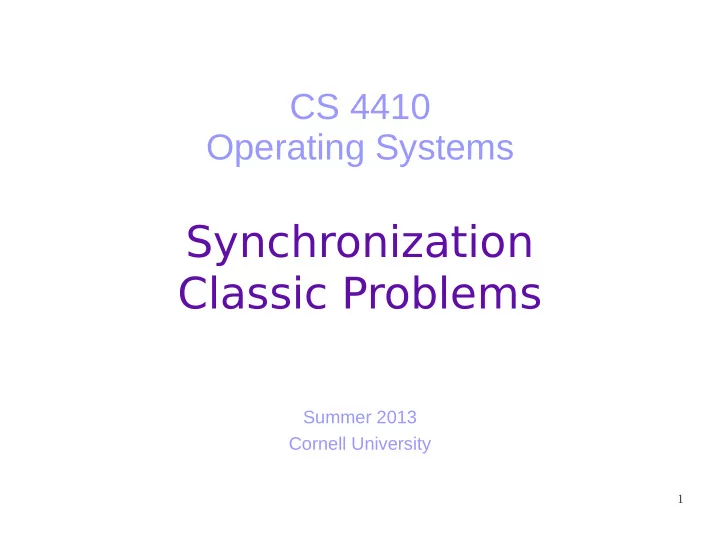

CS 4410 Operating Systems Synchronization Classic Problems Summer 2013 Cornell University 1
Today ● What practical problems can we solve with semaphores? ● Bounded-Buffer Problem ● Producer-Consumer Problem 2
Producer-Consumer Problem ● Arises when two or more threads communicate with each other. ● And, some threads “ produce ” data and other threads “ consume ” this data. ● Real example: Production line 3
Producer-Consumer Problem ● Start by imagining an unbounded (infinite) buffer ● Producer process writes data to buffer – Writes to In and moves rightwards ● Consumer process reads data from buffer – Reads from Out and moves rightwards – Should not try to consume if there is no data Out In 4
Producer-Consumer Problem ● Bounded buffer: size ‘N’ Access entry 0… N-1, then “wrap around” to 0 again ● ● Producer process writes data to buffer Must not write more than ‘N’ items more than consumer “ate” ● ● Consumer process reads data from buffer Should not try to consume if there is no data ● 0 1 N-1 In Out 5
Producer-Consumer Problem ● Multiple producer-threads. ● Multiple consumer-threads. ● One bounded buffer with N entries. ● All threads modify the same buffer. ● Requirements: ● No production when all N entries are full. ● No consumption when no entry is full. ● Only one thread should modify the buffer at any time. 6
Producer-Consumer Problem ● Solving with semaphores: We’ll use counters to track how much data is in the buffer ● One counter counts as we add data and stops a producer if there are N – objects in the buffer. A second counter counts as we remove data and stops a consumer if there – are 0 in the buffer. Idea: since general semaphores can count for us, we don’t need a ● separate counter variable. We'll use a mutex to protect the update of the buffer (“In” and “Out” ● pointers). 7
Producer-Consumer Problem Shared pointers: “In”, “Out” Shared Semaphores: mutex, empty, full; mutex = 1; /* for mutual exclusion*/ empty = N; /* number empty buf entries */ full = 0; /* number full buf entries */ Producer Consumer do { do { //produce item //consume item //update “In” //update “Out” } while (true); } while (true); 8
Producer-Consumer Problem Shared pointers: “In”, “Out” Shared Semaphores: mutex, empty, full; mutex = 1; /* for mutual exclusion*/ empty = N; /* number empty buf entries */ full = 0; /* number full buf entries */ Producer Consumer do { do { wait(empty); wait(full); //produce item //consume item //update “In” //update “Out” signal(empty); signal(full); } while (true); } while (true); 9
Producer-Consumer Problem Shared pointers: “In”, “Out” Shared Semaphores: mutex, empty, full; mutex = 1; /* for mutual exclusion*/ empty = N; /* number empty buf entries */ full = 0; /* number full buf entries */ Producer Consumer do { do { wait(empty); wait(full); wait(mutex); wait(mutex); //produce item //consume item //update “In” //update “Out” signal(mutex); signal(mutex); signal(empty); signal(full); } while (true); } while (true); 10
Readers and Writers ● In this problem, threads share data that some threads “read” and other threads “write”. ● Goal: allow multiple concurrent readers but only a single writer at a time, and if a writer is active, readers wait for it to finish. 11
Readers-Writers Problem ● Access to a database ● A reader is a thread that needs to look at the database but won’t change it. ● A writer is a thread that modifies the database. ● Making an airline reservation ● When you browse to look at flight schedules the web site is acting as a reader on your behalf. ● When you reserve a seat, the web site has to write into the database to make the reservation. 12
Readers-Writers Problem ● Many reader-threads. ● Many writer-threads. ● One piece of data. ● Multiple threads try to access that data. ● Requirements: ● Multiple readers may access the data at the same time. ● If a writer accesses the data, no other thread may access the data. ● What happens when multiple readers and one writer are waiting to access the data? 13
Readers-Writers Problem Reader mutex = Semaphore(1) do{ wrt = Semaphore(1) readcount = 0; Writer do{ /*reading is performed*/ /*writing is performed*/ }while(true) }while(true) 14
Readers-Writers Problem Reader mutex = Semaphore(1) do{ wrt = Semaphore(1) readcount = 0; wait(wrt); Writer do{ /*reading is performed*/ wait(wrt); /*writing is performed*/ signal(wrt); }while(true) signal(wrt); }while(true) 15
Readers-Writers Problem Reader mutex = Semaphore(1) do{ wrt = Semaphore(1) wait(mutex); readcount = 0; readcount++; if (reardcount == 1) wait(wrt); Writer signal(mutex); do{ /*reading is performed*/ wait(wrt); wait(mutex); /*writing is performed*/ readcount--; signal(wrt); if (readcount == 0) }while(true) signal(wrt); signal(mutex); }while(true) 16
Readers-Writers Notes If there is a writer ● First reader blocks on wrl ● Other readers block on mutex ● Once a reader is active, all readers get to go through ● Which reader gets in first? ● The last reader to exit signals a writer ● If no writer, then readers can continue ● If readers and writers are waiting on wrl , and writer exits ● Who gets to go in first? ● Why doesn’t a writer need to use mutex ? ● Is the previous solution fair? ● Readers can “starve” writers! ● Building a “fair” solution is tricky! ● 17
Today ● Which practical problems can we solve with semaphores? ● Producers-Consumers Problem ● Readers-Writers Problem
Recommend
More recommend